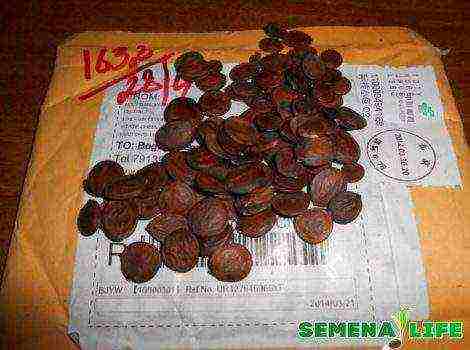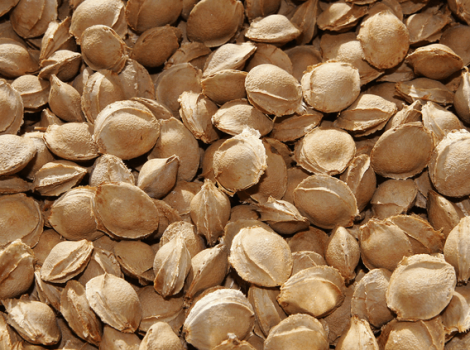Content [show]
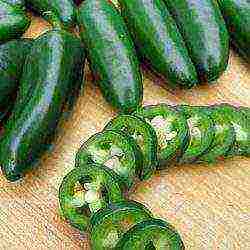 Jalapenos are native to Mexico. The inhabitants of this country are known for their love of spicy dishes. In our latitudes, sweet peppers, such as Bulgarian pepper, are more often used. But still, spicy varieties have fans. Jalapeno peppers are grown in greenhouses and at home. In apartments, it bears less fruit. But it looks very organic in a pot on the kitchen windowsill, also performing a decorative function.
Jalapenos are native to Mexico. The inhabitants of this country are known for their love of spicy dishes. In our latitudes, sweet peppers, such as Bulgarian pepper, are more often used. But still, spicy varieties have fans. Jalapeno peppers are grown in greenhouses and at home. In apartments, it bears less fruit. But it looks very organic in a pot on the kitchen windowsill, also performing a decorative function.
Description of jalapeno peppers
Jalapeno peppers are a perennial plant that multiplies with seeds or seedlings. It can reach a height of 50 cm, but lower bushes bear fruit better. Each plant produces up to 35 flowers, which then become oblong fruits. They grow up to 5-8 cm in length, 2-4 cm in diameter, weigh about 40 g.
Green unripe fruits are eaten, overripe red peppers are valued lower. But even after drying and grinding, they become a seasoning. Or they are exported.
Growing at home and on the site
Jalapenos reproduce in two ways. The first is growing with sprouts. This option is not very successful. Since not all sprouts take root. Therefore, gardeners prefer the second method. This is cultivation by planting seeds. When sowing for the first time, the seeds are bought at the store. All subsequent years, they collect seeds from the largest and most beautiful fruits. Here are the basic conditions for growing jalapeno peppers.
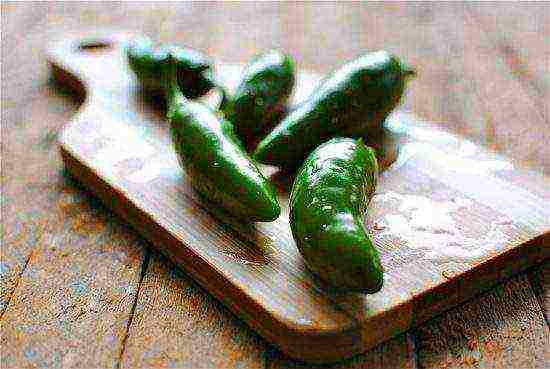
Jalapeno peppers are best grown in a greenhouse
- Before planting, the seeds must be soaked so that they swell. Plain water will do as well. But a solution of potassium permanganate applied to cotton wool is better. Soaking is carried out for at least 2 days. During this time, it is necessary to maintain the moisture of a cotton ball or cotton pad.
- It is necessary to sow seeds at the end of February - beginning of March in the soil prepared and fed with mineral fertilizers.
- Jalapeno peppers are quite thermophilic, so they are sown in a greenhouse or in pots at home.
- The optimum seed depth is 1 cm.
Attention! If the seeds are lowered more than 1.5 cm into the ground, they will not germinate and will rot.
- Immediately after planting the seeds, they must be watered and covered with oilcloth.
- Each day, the sprouts must be ventilated for several minutes.
- After 6-8 days, the first shoots appear. They need to be thinned out by removing weak and ugly sprouts. This way, strong plants will have ample room to grow and develop.
- Pepper grows in 1 - 1.5 months. After that, it is advisable to transplant the bushes from a greenhouse or pot into open ground. But you can also leave them in their original place.
- For growth, bushes need a temperature of about 15-20 ° C, the growing season requires a temperature of about 26 ° C.
- As soon as the bushes reach a height of 20 cm, it is necessary to stop their growth by cutting off the central stem. This is done so that the pepper grows in breadth and bears more fruit.
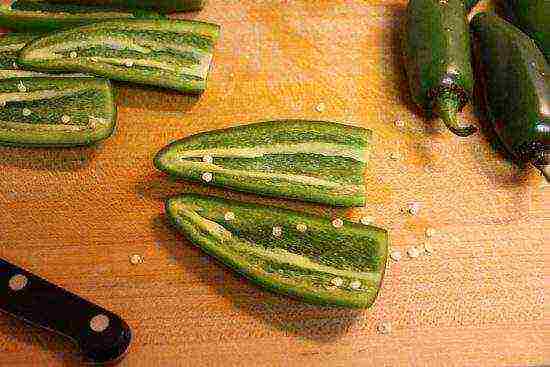
Seeds can be harvested from large fruit
- Jalapeno bushes are watered 2-3 times a week. Since the plant does not accept chlorine and other impurities, the water must be defended. Watering is carried out from a watering can. A strong jet can wash seeds, pull out small shoots or damage stems, leaves, flowers.
- Throughout the growth of peppers, you need to fertilize them once a month. You can use purchased fertilizer for this, as well as droppings of birds or herbivores diluted in water.
Attention! When fertilizing jalapeno peppers with diluted manure, care must be taken that the substance does not get on the stems, leaves or roots of the plant. Otherwise, it can be burned.
- From the moment of sowing until the harvest is complete, it is necessary to monitor the condition of the bushes: remove empty stems, yellow leaves, stalks.
- Harvesting can begin at the end of July. Jalapeno flowers do not open simultaneously, but one by one. Therefore, flowers and fruits of different sizes coexist on the bush for 1.5 - 2 months. This one can be clearly seen in the photo.
- It is necessary to pick the fruits with gloves to avoid burns on the skin.
- Seeds are removed from the best fruits and dried for 3 hours in the sun. After that, they are stored in paper bags.
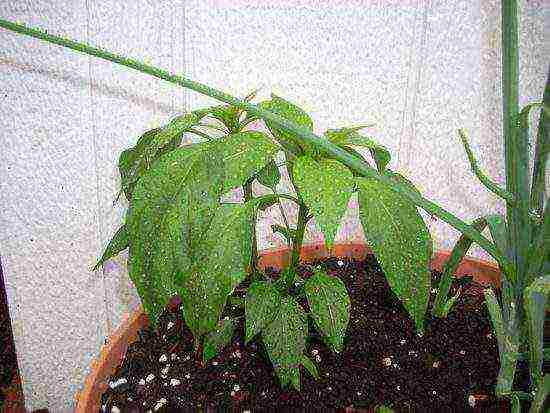
Jalapeno pepper bush
- Jalapeno is a perennial plant. Therefore, you can not completely remove it, but cut it at the root. A new bush will appear next year. It overwinters only at temperatures not lower than 12 ° C. Therefore, for such purposes, a window sill in the house or a heated greenhouse is suitable.
- You need to store the fruits in sealed containers in a dark room. This way you can save the maximum taste.
Pepper use
Jalapeno peppers are most commonly used in cooking. In small quantities, it is added to many dishes. Green fruits are chopped with a sharp knife or fine grater and added to sauces, first courses, stews, meat and fish. Jalapeno peppers are not as hot as our more familiar chili, but they are still hot enough. And heat treatment does not deprive it of its properties. In Mexican cuisine, it is included in more than 90% of recipes. Red overripe fruits are dried, frayed and become an independent spice or a component of a seasoning.
In medicine, jalapeno peppers have also found their niche. Its pulp, and even more so grains, have a warming property. A large amount of the substance on contact with the skin can cause irritation, even burns. But in moderation, fruit powder is added to ointments for joints and lower back. Tincture of pepper, when applied regularly, stimulates hair and nail growth. There are cases when with the help of this plant people partially relieved headaches, or even completely got rid of migraines. Eating a small amount of pepper daily, or even simply lubricating the nostrils, helped to heal.
Among other things, jalapenos can act as a component of self-defense means such as pepper spray and the like.
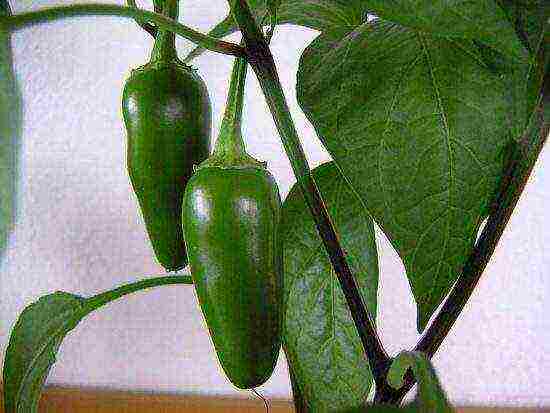
Jalapenos are less pungent than chili peppers
Contraindications to use
Doctors do not recommend eating jalapeno peppers for the following categories of people:
- those who have stomach and intestinal problems;
- suffering from kidney disease;
- people with liver disease.
To reduce the use should be:
- children;
- pregnant women;
- nursing mothers.
Susceptibility to disease and pests
In general, due to its hotness, pepper is not affected by pests. Only one insect can settle on it - a spider mite. Together with the cobweb, you just need to remove it from the leaves and stems and wipe the plant with a cotton swab dipped in water or a solution of potassium permanganate. But all the same, if any infection is found in the greenhouse, it is necessary to get rid of it. Jalapenos are afraid of over or under watering. In the first case, the root will rot, in the second, the flowers will fall off and the fruits will not appear.

Jalapeno peppers are not susceptible to pest attacks
Real gourmets will never give up spicy dishes. Jalapeno peppers can give a bright accent to any recipe. The main thing is to use it in moderation. Vegetables from our own greenhouse are much healthier than imported ones: they are more natural, always fresh and beautiful. A home-grown pepper bush will decorate not only the festive table, but also the interior.
Jalapeno pepper seeds: video
Jalapeno peppers are prized for their strong pungent taste, which is often required for various dishes. Since this type of pepper belongs to the most common genus of chili, amateur gardeners try to grow it at home. In our article, we will tell you in more detail about this plant variety, what diseases and pests usually affect the crop.
Description
Nowadays, it is quite difficult to imagine popular Mexican dishes, wherever hot peppers are added. It is this ingredient that gives them a special piquancy. Jalapeno is one of the world-famous varieties of chili peppers, but Mexicans tend to eat it more often than the hot red. Incredibly, some culinary experts in our country do not even know about the existence of Jalapeno. But in his homeland, he is very popular.
Jalapeno peppers have very pungent enzymes that can irritate the skin when harvested in season. For this reason, it is collected in special protective gloves to keep the skin from unpleasant burns.
There are many varieties of Jalapeno peppers. They can differ in the area of growth, appearance, shade of color, aroma of smells and the degree of pungency of the fruit itself.
Among the most common types of culture, the following three varieties can be found:
- Espinaltico - Sharp-tipped pods
- Peludo - the peppers are thick and long enough;
- Morita - The pods are short and rounded.
Despite the fact that Jalapeno itself belongs to the genus of chili, it is not so spicy that it can be used in more dishes. It is quite suitable for those who try to avoid being too spicy in food.
Since Jalapeno is not particularly whimsical, it can be grown at home - in open ground on the site, in a pot on the windowsill. It grows fast enough. A characteristic feature of the variety is the formation of tall, strong standard bushes. On average, about 30 fruits ripen on each bush. Each pepper has a mass of up to 50 grams, a diameter of up to 3 centimeters, and a length of up to 8 centimeters.
Mostly this type of pepper is harvested when it is green in color. When fully ripe, the fruit turns dark red. Within each fruit, many seeds can be found to plant in the next season.
Fruits that turn red when ripe are considered to be of inferior quality. They can be dried, baked, or buried in the ground. It is also used to make chipotle (a Mexican variety of spices).
Like most types of pepper, Jalapeno contains a large amount of vitamins, rich in sodium and potassium. It also contains trace elements necessary for the human body - iron, manganese, magnesium, calcium, zinc and even selenium. It contains essential oils, vegetable sugars, linoleic acid, carotenoids, havicin, capsorubin.
With regular consumption of Jalapeno peppers, your eyesight (vitamin A) improves. You can also get rid of insomnia, depression, loss of strength, stabilize the cardiovascular system, normalize blood sugar levels, strengthen the walls of blood vessels, improve the properties of the skin and hair.
Despite the small amount of vegetables consumed, it still benefits and has a positive effect on health.
It is strongly discouraged to eat this pepper if a person has been diagnosed with diseases of the gastrointestinal tract, kidney and liver problems.
Agrotechnics
Agrotechnology for growing the Jalapeno crop is simple. Pepper grows well in almost all climates.
Mostly seeds for planting are bought in specialized stores. In the future, they can be taken from the resulting crop.
Before planting, you will need to moisten the seeds in a solution of potassium permanganate to disinfect the planting material. After that, they are laid out on damp cotton wool in a place where direct sunlight will not penetrate.Then you need to cover with gauze and wait up to 3 days. This will keep the seeds in a greenhouse state. It should also be remembered that the cotton wool should not be allowed to dry out, and if necessary, moisturize it.
Planting of pepper is carried out in the spring. Jalapenos are grown for 50 to 75 days. The primer can be purchased directly from the store. The most suitable type of soil will be for flower and vegetable crops. For the normal growth of this culture, it will be necessary that there are minerals and vitamins in the earth.
If gardeners do not have the ability or desire to buy soil, then the land on their site will need to be prepared. This will require preliminary preparation of the landing site. You should take soil, turf, humus, peat, sand and mix them in a separate container. Then you can add some wood ash. After mixing, the prepared soil is poured into seedling boxes.
Sowing seeds is done at a shallow depth, 1 cm is enough. Then the soil is watered from a sprayer, and not with a direct stream. If you sow pepper seeds deeply and pour a lot of water, they will rot in the ground.
Jalapeno loves warmth very much, so it needs to be protected from wind, drafts and cold weather. When growing this hot pepper, it is best to plant in greenhouses. Since the optimal temperature for its growth will be 25-30 degrees, it is necessary to create such conditions that it is easy to maintain. In addition, this plant is perennial and must be preserved for the winter. To do this, in the winter in the greenhouse, you need to adhere to a temperature of at least 12 degrees.
It is advisable to cover the soil with a film not in the first stages of growth. With proper care of the crop at home, you can see flowering in the near future after planting it in the ground. It lasts on average until the middle or end of August.
Plant feeding can be carried out 3-4 times during the whole season. For this, manure of herbivores, bird droppings, wood ash are suitable. You can also use ready-made mixtures from stores, for example, Stimul.
Water the pepper regularly and often. If the land dries up, then the flowering will begin to fall, which will significantly reduce the future harvest. Make sure that the soil is moist at all times, as it requires more water during growth than any other pepper.
Harvesting can begin before the fruit is fully ripe, since time affects the taste of the vegetable. You need to harvest with gloves.
It is better to store plucked fruits outdoors for no longer than 2 weeks. For long-term storage, it is placed in closed containers, rolled into jars, placed in dark and dry places.
Pests and diseases
Since Jalapeno has stinging enzymes, it is almost immune to the attack of insects and other pests. At home, a spider mite may appear, but to remove it, it is enough to simply wipe the foliage with damp cotton wool, washing away all signs of the pest's vital activity.
If you maintain all the conditions for caring for pepper, then it will not hurt. It will also be important to remove all sources of contamination if an infection affecting other crops is found in the greenhouse.
Video "Jalapeno - Super"
In this video, you will learn new data on the properties of Jalapeno peppers.
Jalapeno peppers are prized by culinary experts for the spicy, pungent taste that it gives to the dish. Jalapeno is a relative of chili and is actively used by Mexicans in their national cuisine. In our country, this type of hot pepper is not so common, but in vain: connoisseurs of spicy dishes would like it. In this article, I will tell you how to grow jalapenos at home.
Jalapeno pepper belongs to the genus of chili peppers, it is the hottest pepper in the world, having an international indexation of pungency from 2.5 to 8 thousand points. Green pepper pods are eaten fresh, for this it is important to collect them at the right time.If the moment of ripening is missed, the peppers turn dark red, such pods are dried, crushed and used as a seasoning. The average length of pepper is 5-6 cm, there are specimens up to 9 cm.Jalapeno is a perennial crop, trees with peppers grow up to 50 cm.Gardeners have noted the dependence of growth and fruiting, on low bushes the pods grow more actively, up to 50 peppers per season from one tree ... The flavor of jalapenos is a gradual increase in heat, so be careful with the amount of vegetables in the dish: at the beginning it may seem that there is not enough pepper. Jalapeno peppers are rich in enzymes and substances that stimulate metabolism and improve the functioning of the gastrointestinal tract. But due to the high irritating ability, the use of pepper in food in the presence of allergies or gastritis is undesirable, so as not to provoke an exacerbation of the disease.
Growing jalapenos in the open field is possible, but it is easier to observe agrotechnical features in an apartment. To plant the jalapenos, you will need cuttings or seeds. Jalapeno cuttings are not very common due to the low survival rate of cuttings. Disinfect jalapeno seeds before planting, leave in 1% manganese solution for 1 day. Prepare a fertile soil from organic fertilizers, garden soil and sand (2: 2: 1), do not forget about the drainage of large particles (broken brick, gravel, pieces of tiles).
Consider planting jalapenos in stages.
- In prepared containers, make grooves with a distance between rows of 5 cm.Sow the seeds to a depth of 1.5 cm, in increments of 2 cm.
- Jalapeno is not afraid of direct sunlight, but during the germination phase, find a warm and bright place where the sun cannot reach. Cover the container with glass or plastic wrap.
- Ventilate plantings regularly. When ventilating, spray the soil with a spray bottle. But watch out for mold.
- You can finally remove the shelter after germination, 2 weeks after planting.
- At the stage when 2-3 true leaves appear, cut the jalapeno seedlings into separate pots. The composition of the soil is the same, check for drainage holes in the pots.
- The development of additional shoots indicates the successful rooting of jalapeno bushes. Pinch the tops of the shoots to stimulate growth.
The timing of planting jalapenos at home ranges from January to April. It is worth noting that when planting jalapenos in winter, the plant will need additional lighting with fluorescent lamps, daylight hours are at least 12 hours.
The conditions for growing pepper are not complicated; jalapeno care consists of a number of procedures.
- Air temperature. For a successful jalapeno vegetation, it is necessary to maintain a temperature of 25 degrees.
- Watering the jalapenos. Lack of moisture leads to deformation of flowers and a decrease in fruiting. Water the plant abundantly with room temperature water. Due to the chlorine content of tap water, it is not advisable to water jalapenos with tap water.
- Airing the jalapenos. Bring the plant to fresh air, this procedure is required to prevent jalapeno diseases.
- Top dressing jalapenos. During the flowering period, fertilize every 1.5-2 weeks.
- Jalapeno transplant. As the plant grows, when the plant becomes cramped, transplant the peppers into a new pot. A pinching of the jalapenos is required after each transplant, the procedure stimulates the growth of new shoots.
Hot peppers are used in a huge variety of dishes: salads, minced meat, pizza, and even jams and jellies. Growing jalapenos at home is not difficult. But do not forget about safety: use protective gloves so that the enzymes do not get on the skin, causing irritation, and do not transfer from the hands to the mucous membranes of the eyes.
Everyone is familiar with the chili pepper, which occupies a leading position among the hot types of peppers.But no less interesting and piquant taste has its relative, Jalapeno pepper, which can be easily grown at home and surprise everyone with exquisite Mexican dishes, where it is so often used.

Jalapeno salad peppers
Description of the variety
Jalapeno is a pepper that is a variation of the famous chili pepper. Mexico is considered his homeland, where huge areas of land are allocated for the cultivation of this hot pepper. Named after the city of Xalapa. It is appreciated by culinary experts all over the world for its moderate pungency, which tends to vary depending on the degree of ripeness and the method of preparation. In accordance with the international Scoville scale, this variety of pepper has indicators of pungency in the range of 10-20,000 points, which is an order of magnitude less than that of many types of chili peppers. Roccotillo pepper is less hot than Jalapeno and has 1000-2500 points on a scale, but Cayenne is twice as hot.
Jalapeno has the following features:
- ripening time 65-75 days;
- standard bush, up to 1 m high;
- fruit length 5-10 cm, diameter 2.5-3 cm;
- average weight of peppers 50-60g;
- the shape of the pods is even conical;
- at the moment of technical maturity, the Jalapeno pepper is green;
- yield 1-1.5 kg from one bush.
Jalapeno is a pepper that is harvested in a state of technical maturity (green), ripe fruits that have reached a red color are considered to be of low quality and are used only for drying and drying. Jalapeno is a pepper that has a specific sour taste. The pungency in the fruits is unevenly distributed, the tissues of the seed chambers have the maximum bitterness, removing them, their pungency can be reduced.
This bitter Mexican pepper is grown in different parts of the world. It grows quickly and produces crops. In southern countries it is cultivated as a perennial plant, in the middle lane as annuals. They practice growing this hot pepper on the windowsill.
Useful qualities
In addition to the spicy taste and pungency, which can enrich the dish, it has many useful properties. The large amount of pungent enzyme in Jalapeno peppers has the ability to:
- kill pathogens and prolong the freshness of food;
- improve metabolic processes, promote weight loss;
- increase the production of gastric enzymes, which facilitates the digestion of heavy protein foods;
Jalapeno's scope of application:
- In medicines, to speed up metabolic processes and stimulate appetite.
- In cosmetology, Jalapeno is used in masks for hair growth and masks for cellulite.
- In folk recipes, as a remedy for sweating feet, this is due to antibacterial properties.
All these properties encourage the cultivation of such a pepper on a personal plot, and its agricultural technology will not differ from that used to grow the usual sweet pepper. An excellent option would be to grow a bush on your own windowsill, at home it can be grown as a perennial plant.
Growing
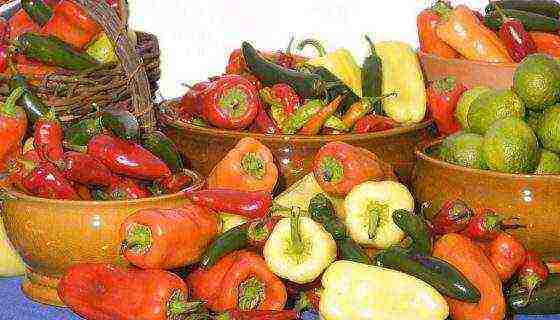
Good harvest
Growing Jalapeno peppers at home is easy.
You can plant a hot Mexican Jalapeno pepper at any time of the year, but it is better to do this in spring, then the young plant will have enough light and warmth, and the biorhythms of the plant will correspond to natural ones. This has a good effect on its development and fruiting.
Soil preparation
The description shows that it is important to select the appropriate planting soil and prepare it before sowing the seeds.
Peppers such as Jalapenos do well in loose, drained, nutritious soils. Ready-made store soil mixture is suitable for growing at home. Universal for flowering plants or specialized for vegetable crops will absolutely meet the requirements. You can also prepare the soil mixture yourself. To do this, you need to mix:
- 5 kg of turf or leaf land;
- 3 kg of lowland peat;
- 2 kg of river sand;
- 5 liters of agroperlite.
The purchased or prepared soil mixture must be disinfected before sowing seeds into it. This can be done thermally or chemically. Thermal consists in spilling the soil with boiling water or calcining in the oven at a temperature of 100-120 ° C. For chemical disinfection, you can use a solution of potassium permanganate or hydrogen peroxide. Potassium permanganate is diluted with a concentration of 1 g per 2 liters of water, peroxide 1 tbsp. l. for 1 liter of water. The soil is spilled with the prepared solution.
Sowing seeds
Seeds must be sown first for seedlings in small containers. These can be plastic containers, cups, peat pots. Before sowing, pepper seeds must be disinfected, and then soaked to swell. Potassium permanganate is used for disinfection. A 1% solution is prepared and the seeds are kept in it for 20-30 minutes. After this procedure, they must be rinsed with clean water. Spread the seeds on a piece of gauze moistened with water or a solution of a growth stimulator, leave for 24-48 hours, making sure that they do not dry out. After such a thorough preparation, the seeds are sown into the soil, sealed to a depth of 1-1.5 cm. The crops are covered with foil. The containers are placed in the brightest and warmest place without drafts. Seedlings appear in 7-10 days.
Seedling care
When friendly shoots appear, they begin to open the film a little, increasing the time that the seedlings are without shelter. After a few days of this hardening, the film is completely removed. Caring for young Jalapeno plants comes down to several rules:
- Regular watering. The soil should not dry out, use warm, settled water, at the initial stage, the seedlings can be watered with a teaspoon.
- Top dressing. It is carried out 10 days after germination. To simplify care, you can use ready-made fertilizers that are suitable for seedlings (Master, Kemira, Gumat).
Already during the period of growing seedlings, you can pinch the top so that the bush begins to branch and does not stretch, this is done when the sprout has 15-20 cm.
Transfer
When 2-3 pairs of true leaves grow on the seedlings, it needs to be transplanted into a pot to a permanent place. Ceramic or plastic with a volume of at least 5 liters is suitable. The ego is filled with a soil mixture, the same as used for sowing the seeds. A deepening is made, spilled with settled water. Seedlings are neat, they will not damage the earthen lump, they are transplanted. The earth around the stem is compacted. After 2-3 days, the transplanted seedlings are watered with a solution of Epin or Kornevin to stimulate root formation and accelerate rooting. The plant will feel comfortable in a bright place with an air temperature of 24-28 ° C, protected from drafts.
Care

Unpretentious pepper
Holopeno is a vegetable variety of pepper that is not picky about care and grows quickly even at home. But compliance with the basic rules in growing will help to get a healthy plant on the windowsill that will delight you with the harvest.
Watering
Adequate watering is the key to the successful cultivation of any plant. Water is essential to support all metabolic processes. With a lack of moisture, plants grow poorly, the process of photosynthesis slows down, nutrients are supplied in insufficient quantities. All this entails irreversible consequences, instead of a lush bush with beautiful hot peppers, a weak plant with single flowers, small fruits and dried leaves grows on the windowsill. In order for the bushes to develop in full force, watering is carried out:
- as the soil dries up;
- separated water at room temperature;
- in evening time;
- at least twice a week.
But waterlogging the soil is also not worth it, excess moisture leads to its stagnation and decay of the root system. To make it easier to navigate, when watering the bush, you can use a wooden skewer, which is inserted into the pot and to check the level of drying, pull it out and check if it is wet.If the skewer is wet only at the bottom, then the plant already needs watering.
Top dressing
Jalapeno is a pepper that requires regular feeding and a sufficient amount of trace elements such as nitrogen, phosphorus and potassium during the period of intensive growth, flowering and ripening of the fruit. Top dressing from the moment of transplantation is applied every 14 days. Mineral and organic fertilizers are used. Pepper reacts well to superphosphate feeding. By introducing it in the form of a solution, 1 g of fertilizer is dissolved in 1 liter of water. Mineral dressings are alternated with organic ones. For Jalapeno, Potassium Humate is ideal; they are introduced in accordance with the instructions, adhering to the recommended dosage. Bushes grow well if they are fed with wood ash. Ash is used in dry form and in the form of a solution. Dry under the bush, close up 0.5 tsp. and watering the soil well. You can also 1 tbsp. l. pour ash 1 liter of water, leave for 12-24 hours and water the plants, for one bush 250 ml of such a solution is enough.
Features of care in winter
Since Jalapeno peppers are perennials after harvest, there is a dormant period after a while. The bush slows down or stops growing, and also partially or completely drops the leaves for 2-3 months. During this period, it is kept at a temperature of 12-18 ° C, watering is reduced to once a week. Also, during rest, you can carry out a rejuvenating pruning of the bush. Top dressing is stopped or applied no more than once a month, with a dosage halved.
With the end of the dormant period, the bush begins to grow new leaves, at this moment it is returned to a warm, well-lit place and regular watering and feeding is resumed.
Diseases and pests
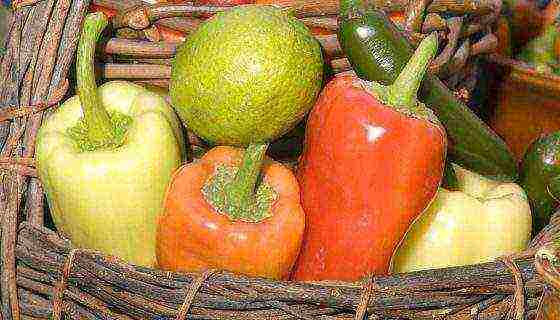
It is necessary to process the pepper during
Even when growing pepper at home, plants are not immune to infection with fungal diseases. Most often this happens due to a violation of agricultural technology at a certain stage of cultivation. Reasons for defeat:
- not disinfected soil for planting;
- untreated seeds before sowing;
- overflow or watering with cold water;
- insufficient watering.
Diseases
For peppers at home, it is common to be affected by diseases such as black leg and apical rot. The black leg appears during the period of growing seedlings, often leading to its death. Excess moisture and watering with cold water stimulates the development of this disease, infection occurs from untreated soil. The symptom of this disease is the thinning of the stem and wilting of the leaves. To avoid the disease, seedlings are treated with Previkur.
When affected by apical rot, the leaves begin to curl, and black spots are observed on the fruits, which turn into depressions. The cause of this disease is an excess of nitrogen, a lack of calcium and insufficient watering. For treatment, 10% calcium chloride is used, 10 ml of an ampoule is diluted in 300 ml of water and the bushes are sprayed twice with a frequency of 10 days. For preventive purposes, peppers can be treated with biofungicides (Biodoctor, Gaupsin) once a month.
Pests
Pests can also infect and harm Jalapeno peppers, especially during periods of high temperatures and dry air. Most often, aphids, whiteflies and spider mites can be found on plants. To combat them, you can use bioinsecticides or folk recipes. They are equally effective and safe.
To combat aphids and whiteflies, use onions or garlic with dandelion. To do this, grind one tablespoon of onion (garlic) and dandelion stalks into a gruel and pour 1 liter of water, infuse for 1 day, filter and add 1 tbsp. l. liquid soap sprayed on the plant. Such a remedy is as safe as possible and can be used even during the fruiting period.
Spraying with ammonia and laundry soap will help with spider mites. Dissolve 1 tbsp in 1 liter of water. l.alcohol and a spoonful of grated soap, knead well and spray the bushes with the resulting solution. During processing, cover the soil so that soap solution does not get there. The next day after treatment, the bush is washed well under the shower. Re-processing is carried out after 5 days. If such methods do not work, then the bushes can be treated with Actarophyte, it is safe, but it has a wide spectrum of action and can cope well with pests.
Pickled peppers (chili) (best jalapeno substitute)
Harvesting hot peppers for the winter - candied fruits from Jalapenos! Real men's food!
The shocking health benefits of pepper!
Jalapeno and Tobasco peppers and tomato. Transfer. Small garden on the window
Conclusion
Simple rules of cultivation and care will allow you to grow a beautiful bush that will delight you with its sharp fruits. They will bring benefits and a new spicy taste to homemade dishes. Jalapeno is a pepper that will easily take pride of place on the windowsill for more than one year.
Similar articles

Reviews and comments
